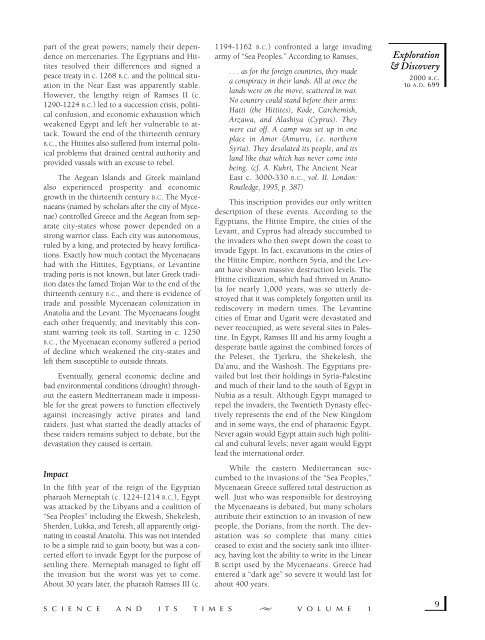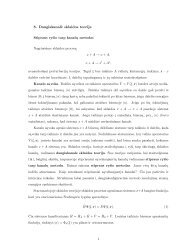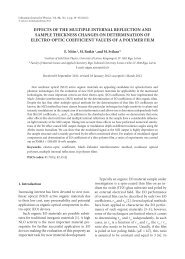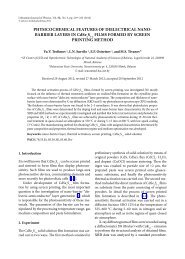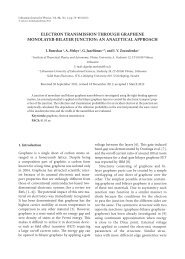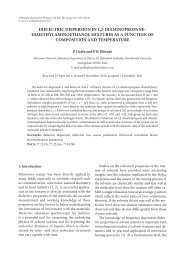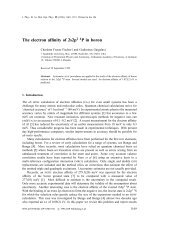Gale - Science and Its Times Vol 01 (2000 BC to AD 699).pdf
Gale - Science and Its Times Vol 01 (2000 BC to AD 699).pdf
Gale - Science and Its Times Vol 01 (2000 BC to AD 699).pdf
You also want an ePaper? Increase the reach of your titles
YUMPU automatically turns print PDFs into web optimized ePapers that Google loves.
part of the great powers; namely their dependence<br />
on mercenaries. The Egyptians <strong>and</strong> Hittites<br />
resolved their differences <strong>and</strong> signed a<br />
peace treaty in c. 1268 B.C. <strong>and</strong> the political situation<br />
in the Near East was apparently stable.<br />
However, the lengthy reign of Ramses II (c.<br />
1290-1224 B.C.) led <strong>to</strong> a succession crisis, political<br />
confusion, <strong>and</strong> economic exhaustion which<br />
weakened Egypt <strong>and</strong> left her vulnerable <strong>to</strong> attack.<br />
Toward the end of the thirteenth century<br />
B.C., the Hittites also suffered from internal political<br />
problems that drained central authority <strong>and</strong><br />
provided vassals with an excuse <strong>to</strong> rebel.<br />
The Aegean Isl<strong>and</strong>s <strong>and</strong> Greek mainl<strong>and</strong><br />
also experienced prosperity <strong>and</strong> economic<br />
growth in the thirteenth century B.C. The Mycenaeans<br />
(named by scholars after the city of Mycenae)<br />
controlled Greece <strong>and</strong> the Aegean from separate<br />
city-states whose power depended on a<br />
strong warrior class. Each city was au<strong>to</strong>nomous,<br />
ruled by a king, <strong>and</strong> protected by heavy fortifications.<br />
Exactly how much contact the Mycenaeans<br />
had with the Hittites, Egyptians, or Levantine<br />
trading ports is not known, but later Greek tradition<br />
dates the famed Trojan War <strong>to</strong> the end of the<br />
thirteenth century B.C., <strong>and</strong> there is evidence of<br />
trade <strong>and</strong> possible Mycenaean colonization in<br />
Ana<strong>to</strong>lia <strong>and</strong> the Levant. The Mycenaeans fought<br />
each other frequently, <strong>and</strong> inevitably this constant<br />
warring <strong>to</strong>ok its <strong>to</strong>ll. Starting in c. 1250<br />
B.C., the Mycenaean economy suffered a period<br />
of decline which weakened the city-states <strong>and</strong><br />
left them susceptible <strong>to</strong> outside threats.<br />
Eventually, general economic decline <strong>and</strong><br />
bad environmental conditions (drought) throughout<br />
the eastern Mediterranean made it impossible<br />
for the great powers <strong>to</strong> function effectively<br />
against increasingly active pirates <strong>and</strong> l<strong>and</strong><br />
raiders. Just what started the deadly attacks of<br />
these raiders remains subject <strong>to</strong> debate, but the<br />
devastation they caused is certain.<br />
Impact<br />
In the fifth year of the reign of the Egyptian<br />
pharaoh Merneptah (c. 1224-1214 B.C.), Egypt<br />
was attacked by the Libyans <strong>and</strong> a coalition of<br />
“Sea Peoples” including the Ekwesh, Shekelesh,<br />
Sherden, Lukka, <strong>and</strong> Teresh, all apparently originating<br />
in coastal Ana<strong>to</strong>lia. This was not intended<br />
<strong>to</strong> be a simple raid <strong>to</strong> gain booty, but was a concerted<br />
effort <strong>to</strong> invade Egypt for the purpose of<br />
settling there. Merneptah managed <strong>to</strong> fight off<br />
the invasion but the worst was yet <strong>to</strong> come.<br />
About 30 years later, the pharaoh Ramses III (c.<br />
1194-1162 B.C.) confronted a large invading<br />
army of “Sea Peoples.” According <strong>to</strong> Ramses,<br />
. . . as for the foreign countries, they made<br />
a conspiracy in their l<strong>and</strong>s. All at once the<br />
l<strong>and</strong>s were on the move, scattered in war.<br />
No country could st<strong>and</strong> before their arms:<br />
Hatti (the Hittites), Kode, Carchemish,<br />
Arzawa, <strong>and</strong> Alashiya (Cyprus). They<br />
were cut off. A camp was set up in one<br />
place in Amor (Amurru, i.e. northern<br />
Syria). They desolated its people, <strong>and</strong> its<br />
l<strong>and</strong> like that which has never come in<strong>to</strong><br />
being. (cf. A. Kuhrt, The Ancient Near<br />
East c. 3000-330 B.C., vol. II. London:<br />
Routledge, 1995, p. 387)<br />
This inscription provides our only written<br />
description of these events. According <strong>to</strong> the<br />
Egyptians, the Hittite Empire, the cities of the<br />
Levant, <strong>and</strong> Cyprus had already succumbed <strong>to</strong><br />
the invaders who then swept down the coast <strong>to</strong><br />
invade Egypt. In fact, excavations in the cities of<br />
the Hittite Empire, northern Syria, <strong>and</strong> the Levant<br />
have shown massive destruction levels. The<br />
Hittite civilization, which had thrived in Ana<strong>to</strong>lia<br />
for nearly 1,000 years, was so utterly destroyed<br />
that it was completely forgotten until its<br />
rediscovery in modern times. The Levantine<br />
cities of Emar <strong>and</strong> Ugarit were devastated <strong>and</strong><br />
never reoccupied, as were several sites in Palestine.<br />
In Egypt, Ramses III <strong>and</strong> his army fought a<br />
desperate battle against the combined forces of<br />
the Peleset, the Tjerkru, the Shekelesh, the<br />
Da’anu, <strong>and</strong> the Washosh. The Egyptians prevailed<br />
but lost their holdings in Syria-Palestine<br />
<strong>and</strong> much of their l<strong>and</strong> <strong>to</strong> the south of Egypt in<br />
Nubia as a result. Although Egypt managed <strong>to</strong><br />
repel the invaders, the Twentieth Dynasty effectively<br />
represents the end of the New Kingdom<br />
<strong>and</strong> in some ways, the end of pharaonic Egypt.<br />
Never again would Egypt attain such high political<br />
<strong>and</strong> cultural levels; never again would Egypt<br />
lead the international order.<br />
While the eastern Mediterranean succumbed<br />
<strong>to</strong> the invasions of the “Sea Peoples,”<br />
Mycenaean Greece suffered <strong>to</strong>tal destruction as<br />
well. Just who was responsible for destroying<br />
the Mycenaeans is debated, but many scholars<br />
attribute their extinction <strong>to</strong> an invasion of new<br />
people, the Dorians, from the north. The devastation<br />
was so complete that many cities<br />
ceased <strong>to</strong> exist <strong>and</strong> the society sank in<strong>to</strong> illiteracy,<br />
having lost the ability <strong>to</strong> write in the Linear<br />
B script used by the Mycenaeans. Greece had<br />
entered a “dark age” so severe it would last for<br />
about 400 years.<br />
Exploration<br />
& Discovery<br />
<strong>2000</strong> B.C.<br />
<strong>to</strong> A.D. <strong>699</strong><br />
S C I E N C E A N D I T S T I M E S V O L U M E 1<br />
9


